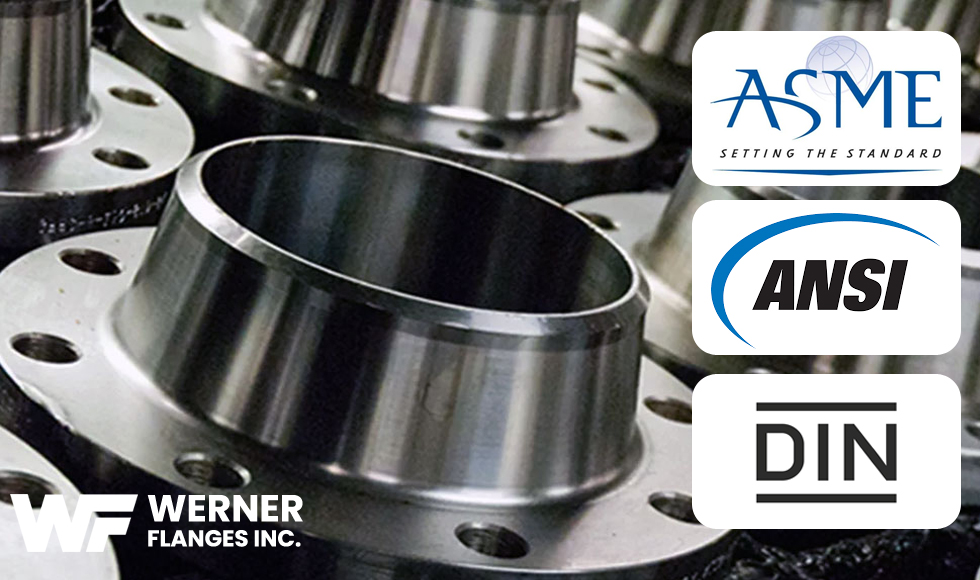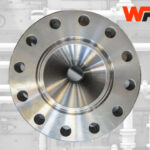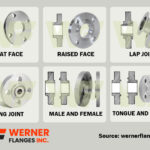Standardization is crucial in the field of industrial pipe systems to guarantee dependability, safety, and compatibility across international supply chains. The dimensions, pressure ratings, materials, and testing requirements of pipe flanges are determined by a number of international standards. To choose the best flange for your particular application, engineers, procurement specialists, and maintenance personnel must be aware of these criteria.
The Major Flange Standards: What’s the Difference?
ANSI/ASME Standards (American)
The American National Standards Institute (ANSI) and American Society of Mechanical Engineers (ASME) have developed the most widely used flange standards in North America and many parts of the world:
ASME B16.5 covers pipe flanges and flanged fittings in sizes NPS ½” through NPS 24″ for pressure ratings from Class 150 to Class 2500. This standard defines:
- Pressure-temperature ratings
- Materials
- Dimensions
- Tolerances
- Marking
- Testing
ASME B16.47 extends coverage to larger diameter flanges from NPS 26″ to NPS 60″, divided into:
- Series A (formerly MSS SP-44)
- Series B (formerly API 605)
The ANSI/ASME classification system uses “Classes” (150, 300, 600, 900, 1500, and 2500) to indicate pressure ratings, with each class having a specific pressure-temperature relationship depending on the material. To understand pressure ratings, you can refer to this guide – https://wernerflanges.com/understanding-pipe-flange-ratings-class-150-300-600-900-1500-2500/
Looking for high-quality ANSI/ASME flanges manufactured to exact specifications? Contact Werner Flanges Inc., one of India’s most trusted flange manufacturers, at sales@wernerflanges.com for competitive pricing and reliable delivery.
DIN Standards (German)
The Deutsches Institut für Normung (DIN) standards were historically the predominant flange specifications in Germany and much of Europe:
DIN 2501 covers flange dimensions similar to ANSI standards but uses different pressure ratings (PN):
- PN 6, PN 10, PN 16, PN 25, PN 40, PN 64, PN 100, PN 160, PN 250, and PN 400
DIN 2633, 2634, 2635, 2636, 2637, 2638 specify details for different pressure ratings
DIN 2527 covers blind flanges specifically
The DIN standard uses “PN” (Pressure Nominal) ratings, which represent the approximate pressure rating in bars at room temperature.
ISO Standards (International)
The International Organization for Standardization (ISO) developed standards that aim to harmonize flange specifications globally:
ISO 7005 is divided into parts:
- ISO 7005-1: Steel flanges
- ISO 7005-2: Cast iron flanges
- ISO 7005-3: Copper alloy and composite flanges
ISO standards also use the PN pressure rating system.
EN Standards (European)
European Norms (EN) have largely replaced the older DIN standards in Europe:
EN 1092-1 covers steel flanges, incorporating many aspects of the former DIN standards EN 1092-2 covers cast iron flanges EN 1092-3 covers copper alloy flanges EN 1092-4 covers aluminum alloy flanges
Key Differences Between Standards
Dimensional Differences
While all standards define similar flange types (slip-on, weld neck, blind, etc.), there are crucial differences in dimensions:
- Bolt Circle Diameter: DIN/ISO flanges may have different bolt circle diameters compared to equivalent ANSI/ASME flanges
- Bolt Hole Size: DIN typically uses metric bolt sizes while ANSI uses imperial measurements
- Face-to-Face Dimensions: These can vary between standards, affecting replacement requirements
- Flange Thickness: DIN/ISO flanges often have different thicknesses compared to ANSI equivalents
Pressure Rating Systems
- ANSI/ASME: Uses Class designations (150, 300, etc.)
- DIN/ISO/EN: Uses PN designations (10, 16, 40, etc.)
While there are rough equivalents (Class 150 ≈ PN 20, Class 300 ≈ PN 50), these are not exact correlations across all temperatures and materials.
Werner Flanges Inc. manufactures all major flange standards—ANSI/ASME, DIN, ISO, and EN—ensuring you get exactly what your project requires. Contact us at sales@wernerflanges.com for expert guidance on selecting the right flanges for your application.
Flange Facing Types Across Standards
All major standards recognize several facing types, though terminology may differ:
- Flat Face (FF): Commonly used with cast iron flanges and when connecting to non-metallic materials
- Raised Face (RF): The most common facing type for steel flanges in process applications
- Ring Type Joint (RTJ): Used for high-pressure, high-temperature applications
- Tongue and Groove: Provides excellent sealing for vacuum or high-pressure systems
- Male and Female: Offers precise alignment for critical applications
ANSI/ASME raised face heights differ between pressure classes:
- Class 150 and 300: 1/16″ (1.6mm) raised face
- Class 600 and higher: 1/4″ (6.4mm) raised face
DIN/ISO standards typically specify a different raised face height of 2mm for most pressure ratings.
Material Designations
Another significant difference between standards is how materials are designated:
- ANSI/ASME: Uses ASTM material designations (e.g., A105, A182, A516)
- DIN/ISO/EN: Uses their own material numbering systems (e.g., 1.0570, 1.4571)
Common material equivalents include:
- ASTM A105 ≈ EN 1.0432 (P250GH)
- ASTM A182 F304 ≈ EN 1.4301 (X5CrNi18-10)
- ASTM A182 F316L ≈ EN 1.4404 (X2CrNiMo17-12-2)
Selecting the Right Flange Standard for Your Application
When choosing between flange standards, consider:
- Geographic Location: Local regulations or common practice may favor a particular standard
- Industry Requirements: Some industries have standardized on specific flange types
- Existing Infrastructure: Compatibility with installed equipment may dictate your choice
- Pressure and Temperature Requirements: Ensure the selected standard offers appropriate ratings
- Cost Considerations: Some standards may be more readily available in your region
Testing and Certification
All major flange standards require various levels of testing and certification:
- Material Testing: Chemical composition and mechanical properties
- Non-Destructive Testing: Methods such as ultrasonic, radiographic, or magnetic particle testing
- Pressure Testing: Hydrostatic or pneumatic testing to verify pressure containment
- Dimensional Inspection: Verification of critical dimensions and tolerances
Proper documentation, including Material Test Reports (MTRs) and certificates of compliance, should accompany quality flanges regardless of the standard used.
Werner Flanges Inc. provides comprehensive testing and documentation for all our flanges, meeting or exceeding standard requirements. Our quality management system ensures complete traceability from raw material to finished product. Contact us at sales@wernerflanges.com for flanges you can trust.
Understanding the differences between ANSI/ASME, DIN, ISO, and EN flange standards is essential for ensuring proper specification, procurement, and installation of piping systems. While these standards continue to evolve toward greater harmonization, the historical differences remain important considerations for designers and engineers.
For all your flange requirements across any standard, Werner Flanges Inc. stands ready to deliver quality products with expert support and competitive pricing. Our decades of manufacturing experience ensure you receive flanges that meet the most demanding specifications and delivery schedules.



